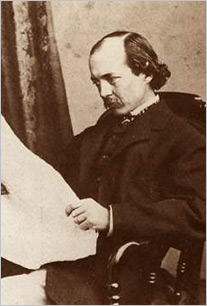 Many people mistakenly believe that Frederick Law Olmsted designed Bushnell Park. Especially given the close relationship between Reverend Horace Bushnell and Olmsted as well as his local roots, you would expect him to have played a role. In fact, Reverend Bushnell asked his life-long friend, Frederick Law Olmsted to design the park. However, Olmsted could not grant Bushnell’s request since he was busily designing Central Park at the time. He recommended that the city hire Jacob Weidenmann, a Swiss-born landscape architect and botanist to design and build the park.
Many people mistakenly believe that Frederick Law Olmsted designed Bushnell Park. Especially given the close relationship between Reverend Horace Bushnell and Olmsted as well as his local roots, you would expect him to have played a role. In fact, Reverend Bushnell asked his life-long friend, Frederick Law Olmsted to design the park. However, Olmsted could not grant Bushnell’s request since he was busily designing Central Park at the time. He recommended that the city hire Jacob Weidenmann, a Swiss-born landscape architect and botanist to design and build the park.
Frederick Law Olmsted is considered the father of the American park movement because of his strong influence in establishing parks throughout the nation. His influence on his associates and others was profound and his design office developed park plans for most major cities.
Olmsted was born in Hartford in 1822, the son of a dry-goods merchant. Although he never completed a formal college education, he attended Yale briefly, and was present at lectures given by Rev. Horace Bushnell and others. He also traveled frequently with his father to see the scenery of New England. Subsequently he traveled throughout the country and to England (twice) and Europe. Also during this time he pursued farming and horticulture with attempts at publishing and writing.
Olmsted read a great deal on a variety of subjects and was impressed by writings related to landscape gardening. In fact, on his first trip to England, when he visited several parks and was already familiar with the park advocacy of Andrew Jackson Downing, he was very much impressed by his visit to Birkenhead Park, near Liverpool. It was England’s first public park developed specifically for the average citizen and executed in the English Natural Style (same as Bushnell Park). Olmsted remarked in a book written later: “…art had been employed to obtain from nature so much beauty…large valleys were made verdant, extensive drives arranged–plantations, clumps, and avenues of trees formed, a large park laid out. And all magnificent pleasure ground is entirely, unreservedly, and for ever, the people’s own. The poorest British peasant is as free to enjoy it …as the British Queen.”
Olmsted was also impressed by other English parks and landscapes. The common elements that appealed to him were: the use of water bodies for interest and beauty, broad, sweeping lawns defined by groves of trees, with some trees standing apart from the main group so that their noble features might be observed; illusions of great distances created through the use of long vistas, middle-distance plantings; undulations in ground form for interest, winding, peripheral paths and drives, which gave the illusion of great breadth. Olmsted later used many of these features, but adapted them and added some of his own, translating what might have been truly English to fit the truly American landscape.
Olmsted saw the value of placing green, open spaces within cities, and was aware of the many problems that faced the country. He felt great compassion for those in need. It is thought that much of Olmsted’s special idealism and beliefs in the goodness of nature was inspired by Rev. Horace Bushnell when they were close friends during Olmsted’s formative years. Recognizing the restorative powers of parks and open spaces, Olmsted said: “We want a ground to which people may easily go after the day’s work is done. Practically, what we want most is a simple, broad open space of clean greensward, with sufficient play of surface and a sufficient number of trees to supply a variety of light and shade. We want depth of wood, not only for comfort in hot weather, but to completely shut out the city from our landscapes.”
Frederick Law Olmsted also believed in the intrinsic value of parks and open ground in what he saw as a nurturing of democracy, a banishment of crudeness and in the beneficial mixing of all kinds of people in this common meeting ground. He urged the public to “plant spacious parks in your cities, and unloose their gates as wide as the gates of morning to the whole people.”
(from: The Nineteenth Century Parks of Hartford, a legacy to the nation. By John Alexopoulos)
